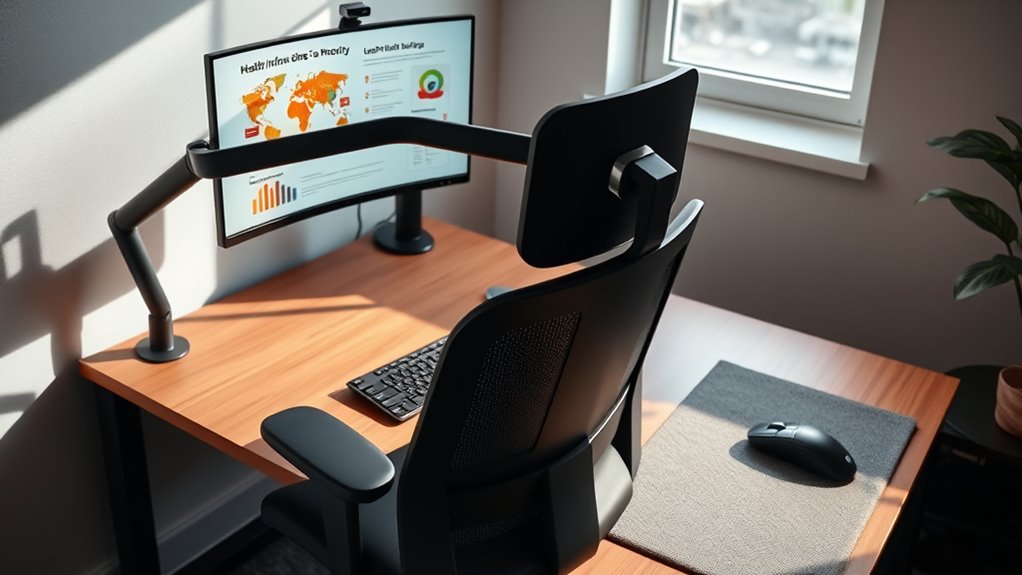Many believe you need expensive gear for an ergonomic desk setup, but that’s a myth. Comfort and health come from simple, smart adjustments like using household items for support, adjusting your chair properly, and positioning your monitor at eye level. Good posture doesn’t rely on costly equipment—it’s about making small changes that suit your body. Keep exploring, and you’ll discover more practical tips to optimize your workspace without breaking the bank.
Key Takeaways
- An ergonomic desk setup does not require expensive equipment; simple, affordable adjustments can improve comfort.
- Proper desk and monitor height are essential; they prevent neck, shoulder, and back strain.
- Using ergonomic chairs correctly with adjustments and accessories enhances posture and reduces discomfort.
- Good ergonomics emphasizes movement and breaks, not just static setup, to promote health.
- Comfort and natural posture are more important than striving for perfect alignment or expensive gear.
Debunking the Myth of Expensive Equipment Being Necessary
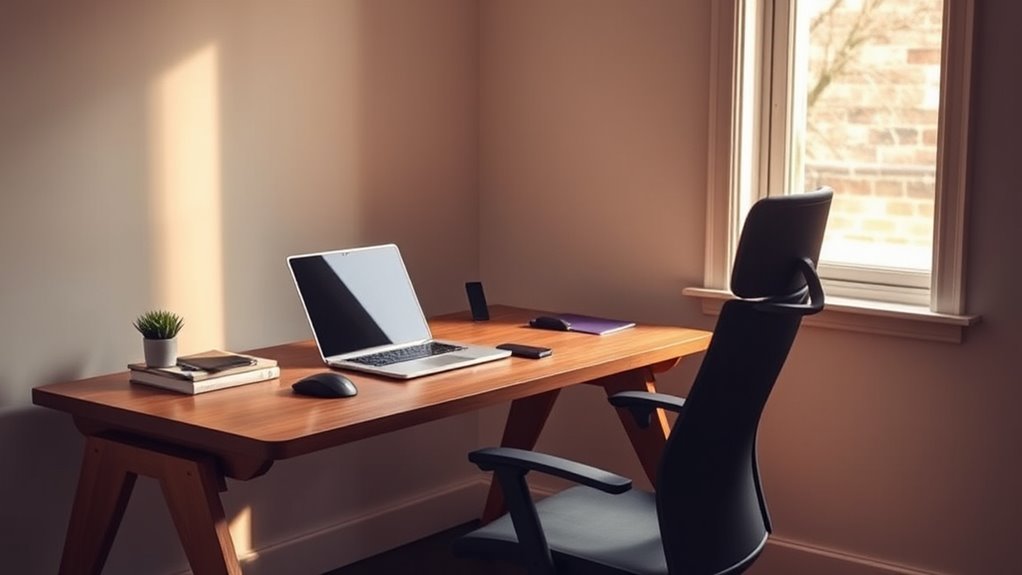
Many people believe that creating an ergonomic workspace requires expensive equipment, but that’s a misconception. You don’t need to spend a fortune to improve your comfort and posture. Affordable solutions and DIY ergonomics can make a big difference without breaking the bank. For example, you can elevate your laptop with household items like books or use a stack of binders for better screen height. Adjust your chair height with cushion pads or find inexpensive footrests online. Simple changes, such as repositioning your monitor or using a supportive DIY wrist rest, can substantially enhance your setup. The key is being creative and resourceful with what you already have. Creating an ergonomic workspace isn’t about costly gear; it’s about making small, smart adjustments that fit your budget. Additionally, understanding the importance of proper workspace setup can help you optimize your environment for comfort and productivity.
The Truth About Posture and Its Impact on Health
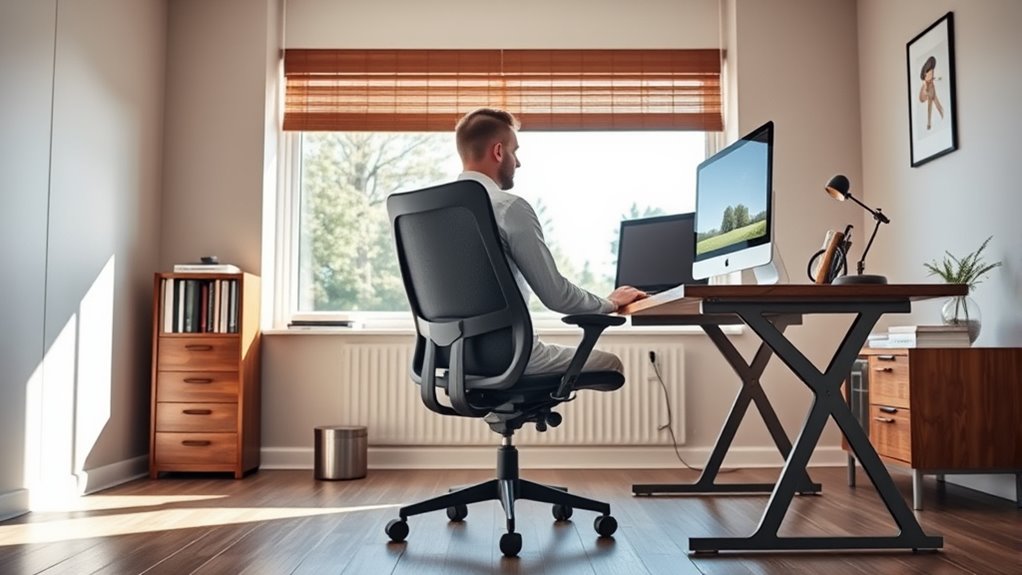
Good posture is essential for maintaining your overall health and preventing discomfort, yet it’s often misunderstood. Many posture myths suggest that perfect alignment guarantees health, but that’s not entirely true. Your posture affects your health impacts, influencing muscle strain, circulation, and mental focus. Standing or sitting upright isn’t always better; comfort and natural positioning matter most. Incorporating ergonomic principles into your workspace can further support healthier habits.
Separating Fact From Fiction on Ergonomic Chair Use
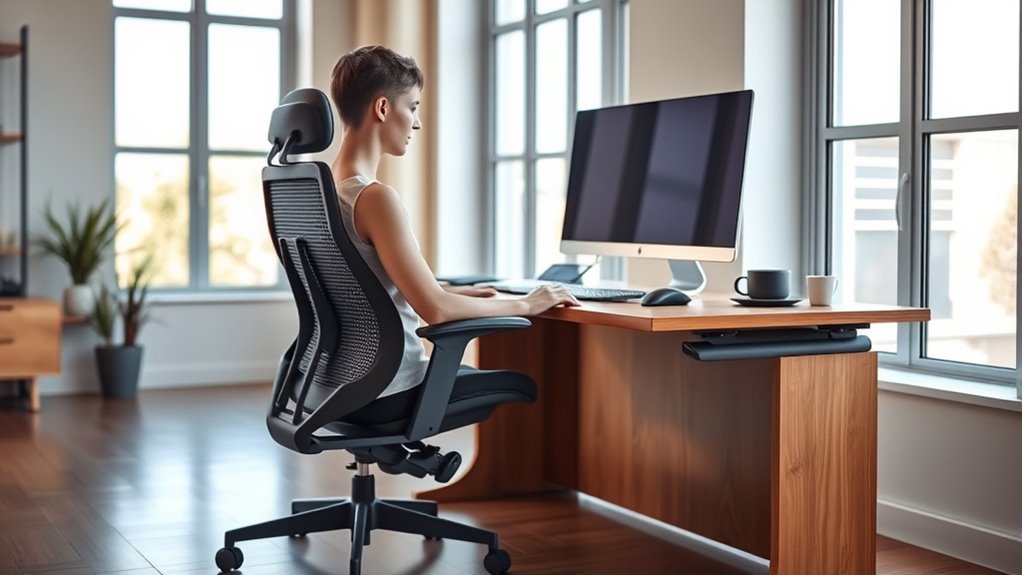
While ergonomic chairs are often marketed as the ultimate solution for workplace comfort, their true benefits depend on proper use and individual needs. Many believe that simply owning an ergonomic chair guarantees good posture, but that’s a misconception. To truly benefit, you need ergonomic accessories like lumbar supports or footrests that complement your chair. Key to maximizing comfort is chair adjustability—making sure your seat height, tilt, and armrests are tailored to your body. Poorly adjusted chairs can cause discomfort or strain, regardless of their design. Remember, an ergonomic chair isn’t a magic fix; it’s part of a setup that requires awareness and proper adjustment to work effectively for you. Understanding forsale 100 and the variety of ergonomic options available can help you make better choices for your workspace. Separating these facts from fiction helps you create a truly ergonomic workspace.
Common Misconceptions About Desk Height and Placement
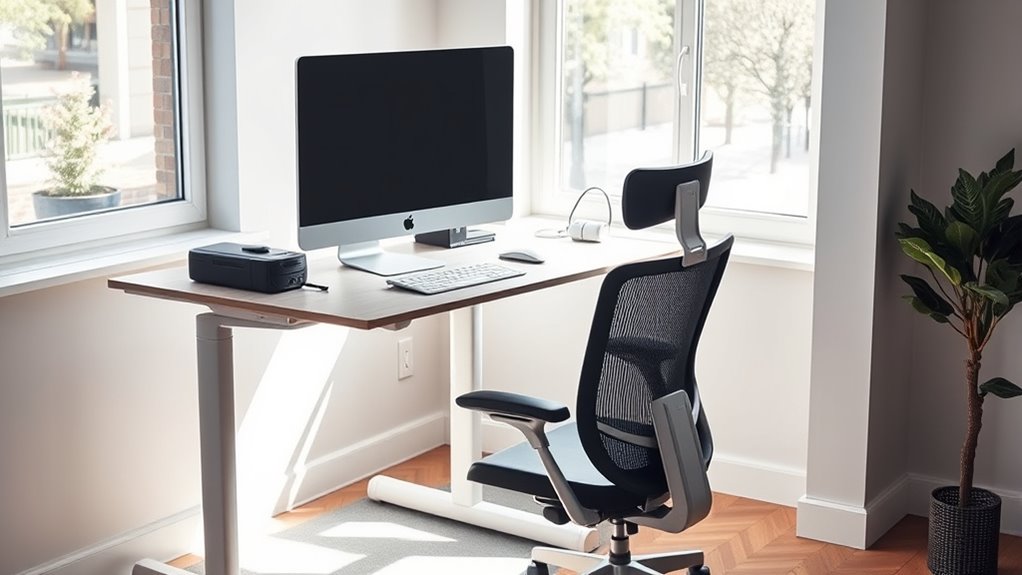
A common misconception is that a desk’s height is only a matter of personal preference, but in reality, it’s crucial for good posture and reducing strain. If your desk is too high or too low, you may experience neck, shoulder, or back pain. Proper desk height ensures your elbows are at a 90-degree angle and your wrists are straight while typing. Additionally, monitor placement is often overlooked; your screen should be at eye level to prevent neck strain. Correct desk height and monitor placement work together to promote comfort and prevent musculoskeletal issues. Using the proper headphone jacks and ensuring your headphones are correctly paired can also improve your overall ergonomic setup. Don’t assume that any desk setup will do—taking the time to adjust your desk height and monitor position is essential for an ergonomic workspace.
Understanding the Role of Movement and Breaks in Ergonomics
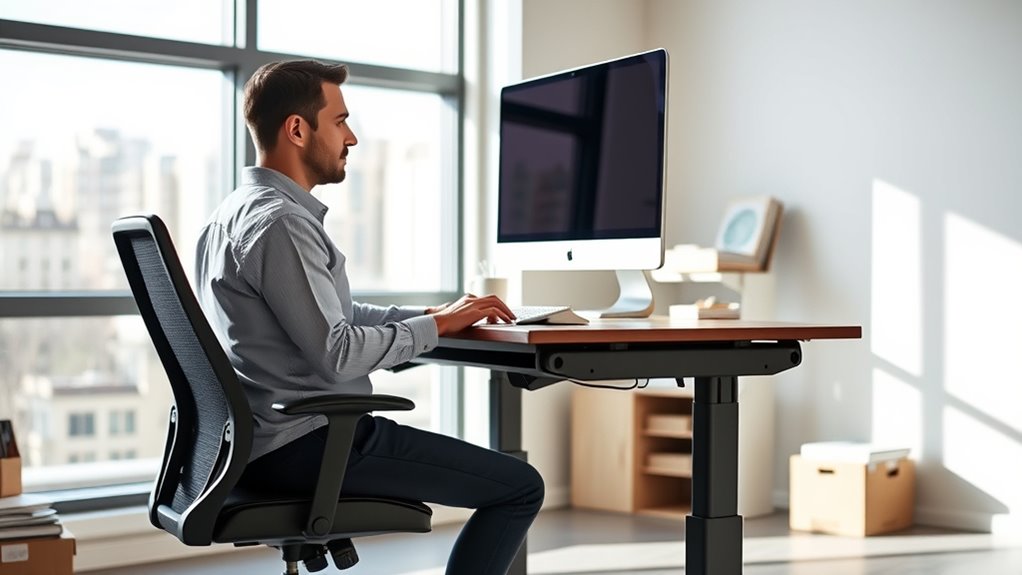
Incorporating movement and taking regular breaks are essential components of an ergonomic workspace because they help prevent muscle stiffness, improve circulation, and reduce fatigue. You should incorporate simple stretching routines during breaks to loosen tight muscles and boost blood flow. Using ergonomic accessories, like adjustable desks or footrests, makes it easier to change positions and stay active throughout the day. Moving regularly also helps reset your posture, reducing strain caused by prolonged sitting. Even short walks around your workspace can make a difference. Remember, sitting still for too long isn’t just uncomfortable—it can lead to long-term health issues. Prioritize movement, take frequent breaks, and use ergonomic accessories to create a healthier, more comfortable workspace.
Frequently Asked Questions
How Can I Customize My Ergonomic Setup on a Budget?
You can customize your ergonomic setup on a budget by using budget-friendly accessories like affordable lumbar supports or adjustable footrests. Try DIY ergonomic hacks, such as stacking books to elevate your monitor or using cushions for better back support. Adjust your chair height and monitor position regularly to find comfort. These simple, cost-effective solutions help you create a healthier workspace without spending a lot.
Are There Specific Ergonomic Tools for Different Body Types?
Think of ergonomic tools as a tailored suit; they should fit your body perfectly. Personalized ergonomics include adjustable furniture designed for different body types, ensuring comfort and support. You’ll want adjustable chairs, desks, and keyboard stands that accommodate your height, posture, and specific needs. This customization helps prevent strain and injury, making your workspace work for you rather than against you. Always choose tools that adapt to your body, not the other way around.
What Signs Indicate My Workspace Is Poorly Ergonomically Arranged?
If your workspace is poorly arranged, you might notice posture problems like slouching or leaning forward, along with discomfort signals such as neck, shoulder, or back pain. You could also feel eye strain or frequent headaches. These signs indicate your ergonomic setup isn’t supporting you properly. Pay attention to how your body responds during work, and adjust your chair, monitor, or desk height to reduce these discomforts and improve your posture.
Can Ergonomic Setups Prevent Long-Term Musculoskeletal Issues?
Can your ergonomic setup truly prevent long-term musculoskeletal issues? Absolutely. By focusing on posture correction through an ergonomically optimized workspace, you reduce strain and promote better musculoskeletal prevention. Proper chair height, monitor placement, and keyboard positioning help you maintain natural spinal alignment, decreasing the risk of chronic pain. Investing in an ergonomic desk setup isn’t just comfort—it’s a proactive step toward safeguarding your musculoskeletal health over time.
How Often Should I Adjust My Desk Setup During the Day?
You should adjust your desk setup at least once every hour to stay comfortable and prevent strain. Make ergonomic chair adjustments as needed to support your back properly, and guarantee monitor height positioning keeps your screen at eye level. Regular tweaks help maintain good posture, reduce fatigue, and avoid musculoskeletal issues. Staying mindful of these adjustments throughout the day keeps your workspace ergonomic and your body happy.
Conclusion
Remember, creating an ergonomic setup isn’t about chasing after shiny gadgets or expensive gear. It’s about tuning into your body’s rhythm, like a skilled dancer finding the perfect balance. Small adjustments—like moving your chair or taking breaks—are your secret tools for health and comfort. Think of your workspace as a garden; with proper care and attention, it’ll flourish without the need for costly fertilizers. Your best posture starts with simple, mindful choices.

